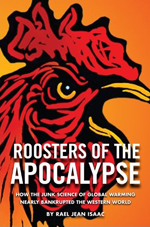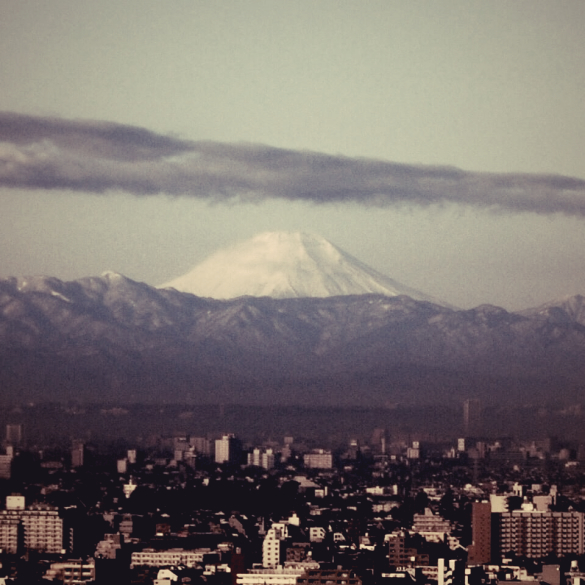When I was a senior in high school my English teacher had us watch Al Gore’s famous (or infamous) movie, An Inconvenient Truth. I did not know what to make of it at the time but I fully believed that my professor would not lead my classmates and me astray. Full of official-looking facts and figures, the argument seemed legitimate enough and Gore was without doubt persuasive. I feel that a scenario like this is how many were first introduced to the issue of Climate Change and after, most believe in the theory to a certain degree. This is exactly why a book like Rael Jean Isaac’s Roosters of the Apocalypse is so necessary. It puts the debate into perspective and propounds the sides of the issue that may not be popular in the public eye but are scientifically correct. Isaac also goes one step further and explains why the Climate Change movement is like any other apocryphal message: it stirs up the masses to create change but fails to deliver in the end. I thoroughly enjoyed this read and I hope that the words that follow will convince you to read it as well.
The general premise of the book and the genesis of its title are found in the distinction between what Isaac considers a “rooster” and an “owl”. “Roosters” are those who, “Crow a new message” to announce a movement and gather support for it. They attempt to sway the opinion of the public towards their beliefs by heralding a popular message supported by evidence that they create and control. Global warming proponents such as Al Gore, heads of powerful environmental organizations like the EPA and Sierra Club, and even our President, Barack Obama, can all be considered roosters. “Owls” are the dissenters to the movement of the roosters and are portrayed as skeptics and “gloomsters” in comparison. Their message is seldom heard because they are drowned out by the roosters’ cries. If the roosters hope to overwhelm the owls’ opposition they must rally the elites in favor of their cause. This is very difficult unless it “pays” to believe in their movement, which in the case of Global Warming it most certainly does. Isaac remarks that, “We need to ask not what we can do for Climate Change, but what Climate Change can do for us”.
The most important, and in my opinion most interesting, component of the book is the comparison of the Climate Change debate to a story of the fate of a small South African tribe in 1856. A 15-year old member of the Xhosa tribe had an apocalyptic prophecy that revealed the end of her people unless certain conditions were met. She claimed that obedience would bring forth a new age characterized by the return of tribal ancestors, an exodus of the British influence in southern Africa, and an abundance of resources much greater than what was found at the time. Following her instructions the tribe destroyed all of their food sources, including burning all stores of grain and slaughtering an estimated 500,000 cattle. By the end of the next year approximately 40,000 people had starved to death, decimating almost half of the original population of the tribe. Isaac contests that the world is following the same path as the Xhosa tribe. Just as the Xhosa gave up their most valuable commodity, cattle, for the misguided revelation of a teenage girl, we too are giving up our most important resource, energy, to appease the environmentalist movement.
 During the main body of the book the author masterfully shows how the Climate Change movement gained so much momentum worldwide, maintained this momentum, and also how it was able to silence dissenting voices. The most imperative part of an apocalyptic message, for Isaac, is that it must be able to change with the times and explain parts of the prophecy that do not come true. The movement in question was originally entitled “Global Warming” but in 2002 the unexpected happened: world temperatures stopped increasing despite continued carbon emissions. Fixing this was easy, however, as the movement was simply renamed a more vague title: “Climate Change”. Now a perpetual rise in global temperatures was not needed to continually validate the theory, proponents simply spoke about how carbon emissions were changing the makeup of the atmosphere and would drastically affect climate in the future. Today as support of the movement is fading, it has been modified once again to focus on “Energy Independence”. The focus has been taken off of any empirical data and instead is placed on developing renewable energies to eradicate our dependence on oil and the foreign powers that control it.
During the main body of the book the author masterfully shows how the Climate Change movement gained so much momentum worldwide, maintained this momentum, and also how it was able to silence dissenting voices. The most imperative part of an apocalyptic message, for Isaac, is that it must be able to change with the times and explain parts of the prophecy that do not come true. The movement in question was originally entitled “Global Warming” but in 2002 the unexpected happened: world temperatures stopped increasing despite continued carbon emissions. Fixing this was easy, however, as the movement was simply renamed a more vague title: “Climate Change”. Now a perpetual rise in global temperatures was not needed to continually validate the theory, proponents simply spoke about how carbon emissions were changing the makeup of the atmosphere and would drastically affect climate in the future. Today as support of the movement is fading, it has been modified once again to focus on “Energy Independence”. The focus has been taken off of any empirical data and instead is placed on developing renewable energies to eradicate our dependence on oil and the foreign powers that control it.
When any apocalyptic message begins to fade, the leaders of the movement must find a way to regain momentum by blaming others. In the case of the Xhosa tribe, when the prophecy was not coming true the people blamed the “owls” who had not believed the prophecy and not recklessly slaughtered their cattle. Today environmentalists blame big oil companies and those countries who have not pledged to lower carbon emissions for their apocalyptic prophecies not coming true. The focus is thus shifted to the new “wrongdoers” who have derailed the conditions set forth in the revelation, whether they are “polluting” the atmosphere or hoarding resources.
An important component of this is also silencing any dissenting voices or evidence that may arise to challenge the message. A very important piece of evidence that arose against Global Warming was the Medieval Warm Period which raised global temperatures high enough from 950-1300 AD to allow the Vikings to establish a prosperous colony in Greenland. This was a glaring flaw in the argument of the environmentalist movement so they simply fudged the data to take it out of the equation. Anyone who has seen An Inconvenient Truth remembers the graph Al Gore uses to show how world temperatures stayed relatively the same in the past few thousand years but have risen exponentially in the past century. Scientists lovingly refer to this graph as the “hockey stick” and snicker about how the Medieval Warn Period and every other unexpected rise in the data have been averaged out by the ridiculous scale of the graph. Like the Medieval Warm Period, leaders and scientists supporting the Climate Change movement suppress the facts that do not support their views by keeping them out of the media, official reports, and scientific journals.
I could continue writing about all of the interesting and insightful things that are contained in Roosters of the Apocalypse but it would only spoil the book for any prospective reader. I do hope, however, that this small taste of what there is to find in the book will whet your appetite enough to give it a chance. Probably the best part about the book is its brevity. Most authors would have dragged out the rhetoric to thrice as long as Isaac does but at fewer than 90 pages this work is the perfect length to stay interesting throughout. I thoroughly enjoyed every page of this book and would give it 9.5 out of 10. On the back of the book it says that Roosters of the Apocalypse is, “Required reading for anyone interested in environmentalism, climate change, or contemporary social movements.” I believe that this characterization is too limited; any informed citizen of this country and this world should read this book. After reading they will not only be better prepared to deal with issues of the present and future but will have thoroughly enjoyed the ride.



